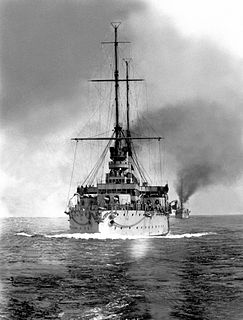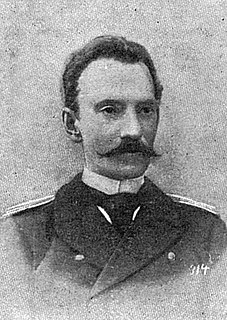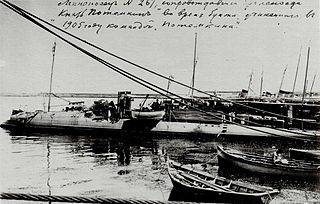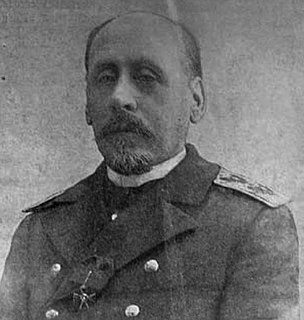
Battleship Potemkin, sometimes rendered as Battleship Potyomkin, is a 1925 Soviet silent film directed by Sergei Eisenstein and produced by Mosfilm. It presents a dramatized version of the mutiny that occurred in 1905 when the crew of the Russian battleship Potemkin rebelled against its officers.

The Romanian Navy is the navy branch of the Romanian Armed Forces; it operates in the Black Sea and on the Danube. It traces its history back to 1860.

The Russian battleship Potemkin was a pre-dreadnought battleship built for the Imperial Russian Navy's Black Sea Fleet. She became famous when the crew rebelled against the officers in June 1905, which is now viewed as a first step towards the Russian Revolution of 1917. The mutiny later formed the basis of Sergei Eisenstein's 1925 silent film Battleship Potemkin.

Neal Shusterman is an American writer of young-adult fiction. He won the 2015 National Book Award for Young People's Literature for his book Challenger Deep and his novel, Scythe, was a 2017 Michael L. Printz Honor book.

Rostislav was a pre-dreadnought battleship built by the Nikolaev Admiralty Shipyard in the 1890s for the Black Sea Fleet of the Imperial Russian Navy. She was conceived as a small, inexpensive coastal defence ship, but the Navy abandoned the concept in favor of a compact, seagoing battleship with a displacement of 8,880 long tons (9,020 t). Poor design and construction practices increased her actual displacement by more than 1,600 long tons (1,600 t). Rostislav became the world's first capital ship to burn fuel oil, rather than coal. Her combat ability was compromised by the use of 10-inch (254 mm) main guns instead of the de facto Russian standard of 12 inches (305 mm).

Dvenadsat Apostolov was a pre-dreadnought battleship built for the Imperial Russian Navy, the sole ship of her class. She entered service in 1893 with the Black Sea Fleet, but was not fully ready until 1894. The ship participated in the failed attempt to recapture the mutinous battleship Potemkin in 1905. Decommissioned and disarmed in 1911, Dvenadsat Apostolov became an immobile submarine depot ship the following year. The ship was captured by the Germans in 1918 in Sevastopol and was handed over to the Allies in December. Lying immobile in Sevastopol, she was captured by both sides in the Russian Civil War before she was abandoned when the White Russians evacuated the Crimea in 1920. Dvenadsat Apostolov was used as a stand-in for the title ship during the 1925 filming of The Battleship Potemkin before she was finally scrapped in 1931.

Artillery Quartermaster Grigory Mykytovych Vakulenchuk was a Ukrainian sailor in the Imperial Russian Navy. He was born in Velyki Korovyntsi. He served on the Russian battleship Potemkin.

Ekaterina II was the lead ship of the Ekaterina II-class ironclad battleships built for the Imperial Russian Navy in the 1880s. Her crew was considered unreliable when the crew of the pre-dreadnought battleship Potemkin mutinied in June 1905 and her engines were decoupled from the propellers to prevent them from joining Potemkin. She was turned over to the Sevastopol port authorities before being stricken on 14 August 1907. She was re-designated as Stricken Vessel Nr. 3 on 22 April 1912 before being sunk as a torpedo target for the Black Sea Fleet.

Georgii Pobedonosets was a battleship built for the Imperial Russian Navy, the fourth and final ship of the Ekaterina II class. She was, however, only a half-sister to the others as her armor scheme was different and she was built much later than the earlier ships. She participated in the pursuit of the mutinous battleship Potemkin in June 1905, but her crew mutinied themselves. However, loyal crew members regained control of the ship the next day and they ran her aground when Potemkin threatened to fire on her if she left Odessa harbor. She was relegated to second-line duties in 1908. She fired on SMS Goeben during her bombardment of Sevastopol in 1914, but spent most of the war serving as a headquarters ship in Sevastopol. She was captured by both sides during the Russian Civil War, but ended up being towed to Bizerte by the fleeing White Russians where she was eventually scrapped.

NMS Elisabeta was a small protected cruiser built for the Romanian Navy during the 1880s by Armstrong in Britain as Romania lacked the ability to build the ship itself. Serving mainly as a training ship, she represented Romania at the opening of the Kiel Canal in 1895. She helped protect Romanian interests in Constantinople during the First Balkan War in 1912–1913, but played no significant part in the Second Balkan War and was partially disarmed during World War I. Employed as a barracks ship after the war, the ship was scrapped in 1926.
Neal Bascomb is an American journalist and author. He is known for his books on popular history.

Afanasy Nikolayevich Matushenko, was a non-commissioned officer in the Russian Black Sea Fleet, revolutionary socialist, and ringleader of the mutiny on the Russian battleship Potemkin.

Ippolit Giliarovsky was the second in command as a frigate captain of the battleship Potemkin during the mutiny. He, more than anyone, was held responsible for the uprising due to his brutal treatment of the sailors. He was killed during the mutiny.

The Russian torpedo boat Ismail was the first ship in the Russian Navy's Black Sea Fleet to join the mutiny of the battleship Potemkin in 1905. The torpedo boat was Potemkin's escort and had on board a complement of three officers, 20 sailors, two 37 mm guns and two torpedo launchers. Ismail brought rotten meat aboard Potemkin in June 1905, an incident which sparked the mutiny. The commander of Ismail was Lieutenant Pyotr Klodt von Yurgensburg, a 41-year-old Russian nobleman.
Vekha was a military transport ship of the Black Sea Fleet that briefly joined the Potemkin mutiny. It was commanded by a colonel, Baron P P Eikhen. On 28 June [O.S. 15 June] 1905, Vekha approached Odessa where the mutineers were burying their fallen leader Grigory Vakulinchuk. Eikhen was unaware of the mutiny so he obeyed a semaphore message telling him to come aboard. Fifteen armed sailors arrested him. He dropped his sabre and was locked up with the officers. The remaining two officers and the doctor were signaled to come aboard, and after their arrest Vekha was ordered to stay by the battleship. The revolutionaries then took it over easily. Its 60 sailors pleaded successfully for the officers' lives, and the officers were set ashore with the others in Odessa.

Higher: A Historic Race to the Sky and the Making of a City is the debut non-fiction book by American journalist Neal Bascomb. The book was initially published by Doubleday on 21 October 2003. The book focuses on the race among the Chrysler Building, Empire State Building, and 40 Wall Street to win the title of the world's tallest building and on architects William Van Alen and H. Craig Severance involved in the projects.

The Winter Fortress: The Epic Mission to Sabotage Hitler’s Atomic Bomb is a 2016 military history book by Neal Bascomb. It tells the story of the Norwegian operation to sabotage the Vemork heavy water plant during World War II.

Grigoriy Pavlovich Chukhnin was an officer of the Imperial Russian Navy during the late 19th and early 20th centuries. In 1904, when he was director of the Kuznetsov Naval Academy, he was nearly offered command of the Second Pacific Squadron before the command was ultimately given to Admiral Rozhestvensky. Rozhestvensky later requested his replacement by Chukhnin during the Pacific voyage, but was denied. In late 1904, Chukhnin was appointed to command of the Black Sea Fleet. He commanded the Black Sea Fleet in 1905 during the mutiny on the battleship Potemkin. In November 1905 he helped crush the Black Sea Fleet uprising. He was assassinated in July 1906, after an earlier attempt in February 1906 failed.
















